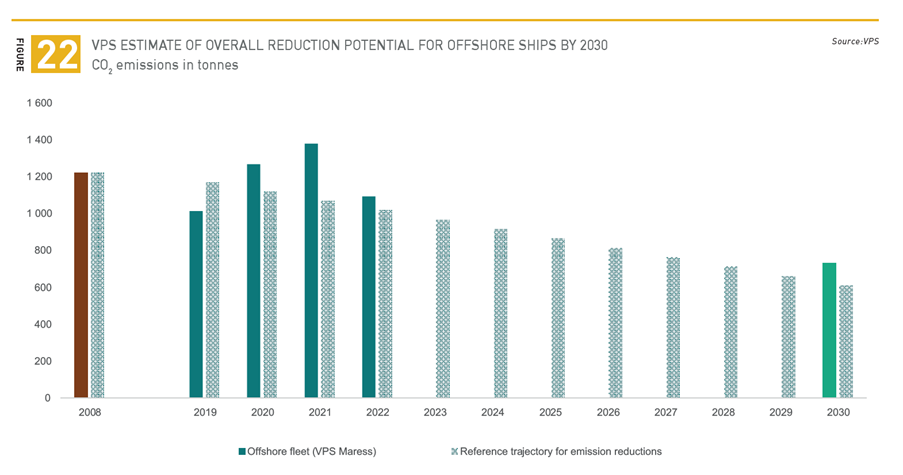Reduced Emissions from Maritime Operations in the Norwegian Offshore Sector by using Batteries
MBF members VPS Decarbonisation and the Norwegian Shipowners Association have contributed to a status report by Konkraft on “The Energy Industry of Tomorrow on the Norwegian Continental Shelf”. Part of this status report (page 40 to 42) discusses the reduced emissions from maritime operations in the Norwegian offshore sector by using batteries on board.
The summary below is part of the status report for those who are interested in learning more about how batteries are helping to reduce the emissions of the Norwegian offshore fleet. To read the full article, please visit: https://www.konkraft.no/main/publikasjoner2/, or download the full report here https://www.konkraft.no/contentassets/9652374dfefe4d50b2b6bc17165d3e08/the-energy-industry-of-tomorrow-2023.pdf
Batteries
The Norwegian offshore fleet is the world leader for installing batteries, allowing some vessels to cut fuel consumption by up to 25 per cent. On average, however, a VPS analysis shows that the improvement achieved after battery installation is only seven per cent – well below the design target of 14-18 per cent. Better routines and use of analysis tools could help to release further potential.
Assessment of further reduction potential
VPS estimates a total reduction potential for the offshore fleet of 40 per cent in 2030 from operational measures (such as speed and route optimisation) as well as by using shore power and batteries. This potential varies between operating modes, from 100 per cent for time in port, 70 per cent for standby ships, 30 per cent for dynamic positioning (DP) and 20 per cent for transit. Viewed overall, realising this potential could cut offshore ship emissions by 40 per cent in 2030.
Figure 22 illustrates a possible reference trajectory for GHG emissions from the offshore ships. Further reductions can be achieved by using alternative fuels once these are available, and by phasing in more energy-efficient ship designs
Alternative fuels
The NSA’s annual member survey identifies the types of fuels and energy carriers which shipowners are thinking of adopting to meet their climate goals. Figure 23 presents the figures from the 2023 survey. Rankings given by companies in offshore shipping are the same as in other trades, but they regard hybrid electricity as even more relevant than the average respondent – at close to 80 per cent. The ammonia and biofuel categories have increased the most over the past four years.
Newbuilding and replacing old ships
The offshore fleet on the NCS is getting steadily older, and the climate potential from greater energy efficiency and converting to alternative fuels in an ageing fleet will be limited. Newbuilds with zero-emission technology and an energy-efficient design will therefore be relevant in the years up to 2030.
Norwegian shipping companies plan to order 215 new ships over the next five years, with growth in such intentions particularly strong for offshore service. From 25 vessels in 2020, this segment now has plans to build 84 – a large proportion of them for the offshore wind industry. Nine of 10 companies report that they will equip the ships with climate-neutral technology.
Installing battery and charging system
Upgrading Solstad’s Normand Ocean has cut its fuel consumption by 25 per cent after installing a battery and charging system. The company has also installed battery hybrid solutions in nine PSVs.
First offshore ship to run on ammonia
Supply ship Viking Energy will be converted to run for long distances on green ammonia. The EU has awarded NOK 100 million to the project, which will pave the way to zero-emission vessels. Owned and operated by Eidesvik, Viking Energy will continue to ship supplies to Equinor’s installations after the conversion. Eidesvik first installed propulsion systems based on LNG a number of years ago. In recent years, the company has invested in battery packs for a number of its ships.
Supply ship running on biogas
Island Crusader ranks as the world’s first carbon neutral supply ship and the first on the NCS to run on biogas. Its fuel is derived from fish waste and cattle dung. Owned by Island Offshore, Island Crusader is a 10-year-old supply ship displacing 8 500 tonnes fully laden. It has previously run on LNG, with maximum annual emissions equivalent to 2 000 fossil-fuel cars. It made its first voyage with net zero operating emissions in November 2021.





